-
Posts
1,630 -
Joined
-
Last visited
Content Type
Profiles
Forums
Store
Help Articles
Posts posted by markk
-
-
Here's a link to a description of what you ate, and links to a video of one being made in a little country inn on the outskirts of Strasbourg. It is indeed called "Tarte Flambée", which is the literal translation of the German "Elsässer Flammekueche" (well, not quite so - the first word, "Elsasser", means "Alsatian" in German, and the second word means "flame kissed", and is the translation of "flambée" in this sense, meaning that the intense flames of the oven char the outsides of the dough. As you'll see in the video, it spends less than a minute in the blistering-hot oven.
I've spent tremendous amounts of time in Alsace, and that's how we got this video of me actually participating in the making of the "Tarte Flambée".
It is not an Alsatian Onion Tarte, which is a custard based tart in a pastry shell, and certainly no a Quiche Lorraine.
I have consumed hundreds of them all over Alsace - I have never been offered one without "lardons" - small chunks of bacon. (The Trader Joe's version is inauthentic by its omission of bacon) - and for what it's worth, there's bacon in the custardy Alsatian Onion Tart as well).
Here's the post with a bit of a story, and the links to the video:
Mark. Thanks for the video. That is exactly what I remember having. I don't have a wood fired oven, but I do have my trusty old Weber grill and a baking stone. I am sure I can get that insanely hot. The key thing is finding the correct crust formula. Lots of experimentation to be done.
Dan
Edit... regarding the pork. It could be that the family I was staying with asked them to make it without the lardons. After 15 years, my memory isn't exactly perfect. I will have to try veg bacon or ham to see if they will work as a substitute.
Dan
It's a normal bread dough ("pain ordinaire"), like baguette dough, but without the yeast; so it's flour, water, and salt. It is absolutely unleavened. The problem will be getting it thin enough. Those places actually use a machine (like a pasta rolling machine) to get the dough so thin. They put in a round piece piece of dough, and it comes out really, really thin.
-
Here's a link to a description of what you ate, and links to a video of one being made in a little country inn on the outskirts of Strasbourg. It is indeed called "Tarte Flambée", which is the literal translation of the German "Elsässer Flammekueche" (well, not quite so - the first word, "Elsasser", means "Alsatian" in German, and the second word means "flame kissed", and is the translation of "flambée" in this sense, meaning that the intense flames of the oven char the outsides of the dough. As you'll see in the video, it spends less than a minute in the blistering-hot oven.
I've spent tremendous amounts of time in Alsace, and that's how we got this video of me actually participating in the making of the "Tarte Flambée".
It is not an Alsatian Onion Tarte, which is a custard based tart in a pastry shell, and certainly no a Quiche Lorraine.
I have consumed hundreds of them all over Alsace - I have never been offered one without "lardons" - small chunks of bacon. (The Trader Joe's version is inauthentic by its omission of bacon) - and for what it's worth, there's bacon in the custardy Alsatian Onion Tart as well).
Here's the post with a bit of a story, and the links to the video:
-
I just discovered that I have posted photos of the foods you mention, above.
I've had the sauteed foie gras there twice, and it wasn't overcooked. It wasn't a particularly generous portion, and was even less generous the second time, but it wasn't overcooked either time, so I think that you just got a bad cook.
I was told that the trotter was stuffed with the meat of the foot, and mine had that gooey, gummy consistency and taste to it. I can't remember now whether or not there was the taste of foie gras, but I remember liking it, and thinking that it was a treat to get something like that, which you don't find often. I think that you got them on a bad night.
I don't think that French food gets "Americanized" nearly to the extend that Asian food does. I mean, I'm sure that there are places that do Americanize the food - though they're not places that I would go to. But I've never thought that any of the French places in NYC are Americanizing their food. I've though that it's not usually as good as you can get in France, and perhaps they omit some of the more shall we say "interesting" dishes, but I don't think that your disappointing experience at L'Absinthe was a case of "Americanization" - I think you got them on an off night.
We drink the Willm Pinot Gris there as well. I think that they get points for having this. I think that as a rule, Alsace wines are sorely under-represented in French restaurants here, and while I do know of some places that have nice Pinot Blancs by the bottle, I think it's rare to find a place with any Pinot Gris, which is a shame, because it's such an elegant and food-friendly wine.
Sorry to hear about your disappointing dinner. I don't know if the place is that sensational that I would tell you to try it again, but I have enjoyed the two meals that I've had there - I guess I lucked out.
-
I haven't been in a while, so we might need some people to weigh-in with recent visits, but Cafe Matisse in Rutherford has always been a great place for special occasions, and believe it or not, they actually pull-off the dishes on their menu in a very impressive way. It's BYO too. But the food has always been pretty exceptional.
-
Well, there are some questions that I have been asking for years (and have posed them on eG as well):
How did it come to be that we knew that the way to get the caffeine out of the coffee bean was to roast the bean, grind it up or pulverize it, and use hot water to extract what's in there and drink he water, yet at the same time we learned that to get the calming nicotine from tobacco leaves it was best to dry the leaves, light them on fire, and inhale the smoke? I mean, why is it that we're not smoking coffee beans in a pipe, and making a brew or a tea from tobacco leaves?
-
I just called New Lok Kee prior to driving out to Flushing, and a phone company recording tells me that the number is temporarily disconnected!
Does anybody know anything about this?
Thanks!j
-
I'm from NY, spend several weeks a year in Hollywood, and eat most of my meals at Michy's.
The subject just came up with a foodie, and I would say that Michy's definitely has qualities that you can't get in New York. I think it's well worth going to for dinner. I've been known to be in Miami (Holllywood) for ten days at a time and eat 7 dinners at Michy's.
-
Thanks, all. Bar Boulud is the obvious answer, though one would need to make a reservation, and part of the post-opera dining equation is that one isn't really sure in advance whether one will want anything more than cake and milk at home. Still, Bar Boulud it shall be after La sonnambula later this month.
Well, I always know that I want dinner after the opera if I haven't had it before the performance!
And while I'm pretty sure this isn't the right board for this, if you're going to Sonnambula at The Met some things you'll probably want afterward are throat lozenges (from all the booing you'll probably be doing), and some baby wipes in case you were in the path of the rotten tomatoes being thrown at the stage. And alcohol - copious amounts, and luckily Bar Boulud has that! (And a notepad to write yourself a reminder never to see another Mary Zimmerman production again, because hopefully the previously mentioned copious amounts of alcohol will probably make you forget that vow - which you will more than likely be making on your way out of the opera house).
-
Having already sent back the mains, which most people wouldn't do (to the long-term detriment of the restaurant), would I then take the further step of a confrontation over the bill? I think despite the comments from our armchair critics, I probably wouldn't (and would suggest strongly that they wouldn't also if they were really in the situation rather than at their computer screens).
I read a lot of similar discussions, and am criticized for not saying anything when a restaurant screws up, but it's usually because I think that the situation is hopeless, that my comment would accomplish nothing, and because I particularly don't feel that it's my responsibility to teach the restaurant how to do its job properly - and still I'm told that whatever it was, was my fault, because I didn't want to say anything, and certainly didn't want to get involved in a "scene". But, to me it is a given that if I send back a dish because it's so poorly or improperly cooked that I can't eat it, I'm not going to be charged for it, or pay for it. But if it does appear on the bill, I certainly will point out that we sent the dish back because it was inedible. That to me is not a "scene", that's pointing out an error on a bill, which I do all the time.
-
They seem to keep changing it, but you can get the full "hot" menu at Bar Boulud until midnight a lot of nights - and last week we strolled over after a "La Sonnambula" at the Met and had time for a full Bar Boulud meal from the main (hot) menu- but you should call and check because it varies, and on some nights, they stop the hot food at a certain point and keep the charcuterie going another hour. So be sure to ask what time the "hot" food ends. Though I have certainly made many a post-performance meal out of their charcuterie.
And you can gat a full meal until 2 at Landmarc, though it's not great and it gets tired fast.
As far as cabbing it to other places, a lot of the places that are open late are in neighborhoods that have on-street parking, so rather than cab it, we take the car out of the Lincoln Center garage and drive to someplace for dinner and park there, making a cab back up to Lincoln Center not necessary.
It was rare that we stayed up there after the last Met performance, and I don't really know why we did. (We did because the time before that at Bar Boulud we had a delicious pasta dish with shrimp and black truffles, and we were hoping there would still be truffles:

but alas there were not.)
-
However there is the possibility there was miscommunication between the manager and server.
That was my first thought, since it's unthinkable to me that they'd have charged you for food that you couldn't eat; I suspected that they meant for the items to come off and to buy you dessert, and that somehow that got misunderstood.
-
The entrees should have been removed from the bill, and when you saw that they weren't, you should have called over the original woman, and told her that while she couldn't "make it right", she could certainly lessen the damage by not asking you to pay for food too horrible to eat.
Some years ago my partner and I were in the (then) very upscale Emeril's in Miami Beach (in the old days, the original Emeril's in New Orleans was also quite upscale, and a benchmark of gracious service and attention.
Anyway, we were greeted warmly upon our return (we'd been there the year before) and the chef sent out a number of little first courses. Plus, we had ordered starters. My partner found his main course less than edible, but chose not to say anything (I told him he should), but he said that he was full, and just didn't want to make a stink. Anyway, when the waiter cleared the plates, he saw the uneaten plate and asked, "was the dish not to your liking?". and my partner said that it really was not. An offer of a replacement dish was made, and my partner declined it, but there was no discussion of any compensation. And in fact, when the bill came, nothing was said about the main course - it did NOT appear on the bill, but they didn't point that out either. They simply didn't charge for a main course that didn't get eaten, even by a customer who chose not to speak up and say something at the time.
I thought that their handling of it was exemplary.
-
I don't cook/prepare a lot of foie gras myself, because I eat it out with great frequency. But after reading through this whole thread, I thought that some members might enjoy photos of different foie gras preparations that I've had, so I searched my photo archives, and here we go...
A cold preparation, from the restaurant "Auberge du Cheval Blanc" in the village of Schweighouse-Sur-Moder in the Alsace region of France:
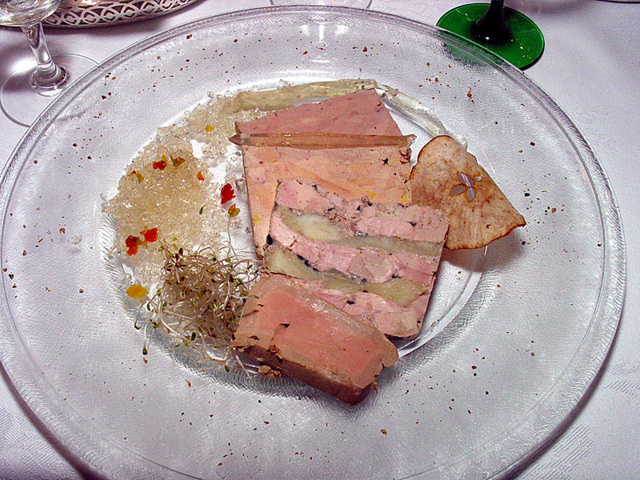
A selection of four cold preparations of foie gras: Duck Foie Gras, Goose Foie Gras, Marbled Duck Foie Gras with Sauternes, and Smoked Foie Gras. (I don't think that the plate of all four was ever on their menu, but the owner, a friend, knew that we were foie gras fiends and served it to us.
And a very excellent cold foie gras terrine from "Blue Ribbon Brasserie" in New York City:
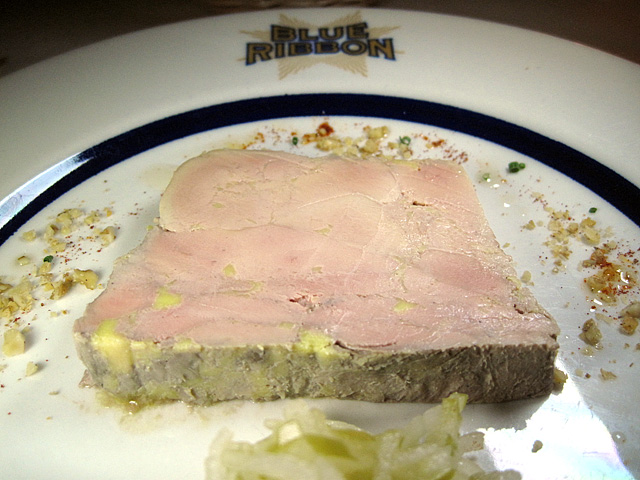
Next, some hot foie gras preparations.
From the "Restaurant du Faude" in the village of Lapoutroie, in the Vosges mountains of Alsace, "Cromesqui de Foie Gras" (whole, as it's served, and then cut open):
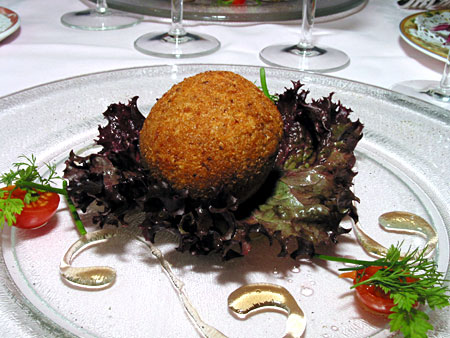
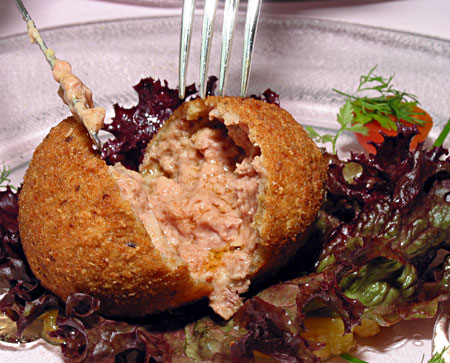
From the restaurant "Le Cerf" in Marlenheim (Alsace), a giant raviolo of smoked and poached foie gras, in a "pot au feu bouillon", covered in fresh black truffle slices:
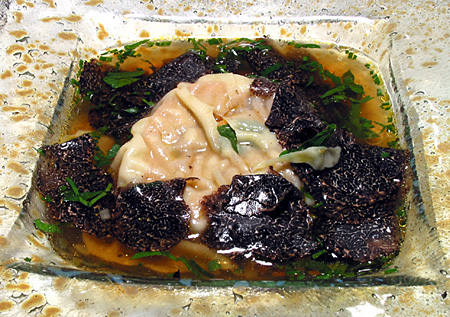
And from "Michy's" in Miami, two different servings of sauteed foie gras over a corn pancake with savory maple syrup:
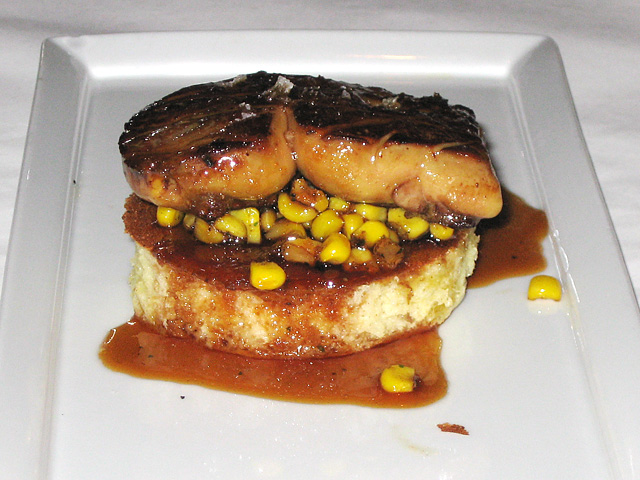
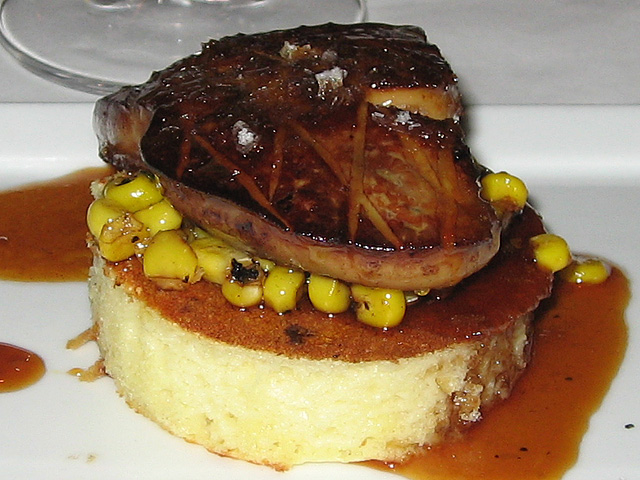
Well, I hope everybody enjoyed.
-
D'Artagnan sells a "blister-package" of two slices of raw foie gras lobe - you know, the thing where the plastic is laminated to a card. I know this for a fact, because I buy them in my supermarket all the time.
I don't have a photo of the package, but here's the contents - two very nice slices, sizzling in a pan on my stove:
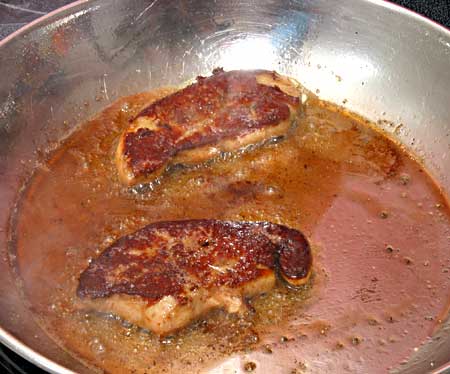
I can't find this product on their site, but it would be worth calling them to ask for it mail-order. As I say, I buy it all the time in my supermarket.
As far as the packaged Rougie foie gras products, I think that they're just awful, and at one point I started a thread about it where everybody agreed.
But if you're looking to experiment with sauteed foie gras, call D'Artagnan and ask for the packaging I described, and give it a try - it's really not that hard.
-
Well, I think the first thing you should do is find out if Harold Jaffe still owns the place. I've had some problems in the past, discovering errors in my take-out orders when I got them home (I live too far to drive right back), and he's been very gracious about remedying them. If he is still the owner, you should ask for him. If he's not still the owner, it sounds like you're out of luck, and that the new owner(s) have changed the place, and don't care.
Well, after I wrote that paragraph, I called them to ask if Harold Jaffe was still the owner, and the answer was "yes". So you might want to call him and tell him your entire story, and post to let us know what he said and how he handled your complaint.
I'd be very curious to hear the outcome, and what he had to say about the pastrami.
Edited to say that after I posted this reply, I read your message again carefully - you're talking about the Lyndhurst "Harold's", which is not owned by Harold Jaffe, and which never even got their pastrami from the Edison "Harolds", which is the only location that he owns. (I always found it very strange that when he sold the name to the other locations, he didn't require them to buy the meats from him.)
In my opinion, the Lyndhurst location really can't have gone downhill from the last time I tried it, because there wasn't any room to go before reaching rock bottom. Their pastrami has always been horrendous. The manager had told me once when I sent a sandwich back and left, where they got it from, but I can't remember. But it was terrible, and it's hard for me to imagine that they found a worse one to buy. (It really doesn't have anything to do with a "recipe", it has to do with a "supplier".)
So disregard everything that I wrote above.
I'm surprised that you could ever have like this location's pastrami.
-
My meal certainly featured one of the best duck confits I've ever had (and I may eat more duck confit than anybody else alive), and the oysters were simply magnificent, as was the arugula salad. I think that Fat Guy did us all a favor sharing this with us. Lord knows, I'm goin' back!
-
When I was there (byo'ing) a few weeks ago for the duck confit skillet dinner, I studied the wine list - it looks really good and quite reasonable, and was a pleasant surprise on both counts!
-
This mention NY Magazine http://nymag.com/restaurants/features/54669/ makes me wonder if anybody is familiar with Savoy Restaurant? I've never heard of it.
And has anybody had the cassoulet there?
-
Just got back from Beacon and, ugh, I'm full. In a good way though, so all is well.
We really enjoyed ourselves, and I must say it was quite the bargain. This is not complex or overly ambitious food but it is satisfying. I think these Sunday suppers find a nice balance between quantity and quality that is hard to beat. We got in there for the last of the $35 pp events, but even at $44 it's a good deal. With that said, it would make me very happy if for some reason this $35 offer was extended for another month of so.
The service was very accommodating. We brought three bottles of wine, one of which was a bit older and not cellared all that well that was decanted without hesitation. Requests for mutltiple wine glasses and the like also were graciously accommodated. I did feel that the servers were stretched a bit thin--perhaps on a relatively lazy Sunday they had less servers on the floor--but once we got their attention nothing was too much trouble. Any technical quibbles on the service front were more than made up for by a feeling of genuine hospitality.
As for the food, it was all very agreeable. Not the best I've had by any imagination, but the kind of food you wish you were served at a dinner party but aren't. The soup, to me, was the weakest dish. Too thick and a bit one-note. Other than that, no real complaints. I might want a bit less cheese on the pizza or a lighter hand with the red onion on the oysters, but I'd happily eat these again and again if placed in front of me. The salad serves as a nice transition course of sorts. We had two plates with our appetizer and another plate with our main courses.
The skillet special on this evening was jambalaya. To be honest, I wasn't super psyched about this offering going into the meal. Duck confit or braised venison sounded more exciting. I must say, however, Beacon over-delivered on this dish. Very large shrimp, hunks of sausage, crispy chips of ham, and pieces of chicken sat atop a rich rice and spicy gravy mixture. We ordered two rounds of this. We also tried the chicken and the salmon, both of which, I believe, are cooked in the wood-burning oven. I can't fault the cooking of these dishes, but both could've used a bit more salt. To my mother they were fine, but I thought them a little underseasoned.
The dessert was simple and satisfying. Of the make-your-own sundae components, the strawberries were the consensus favorite.
A really nice and satisfying meal. Exactly the kind of thing you want on a Sunday evening with family. I confess, since this was the last week the Sunday supper was being offered at $35 I felt the need to go. Still, I intend to go back when the right skillet special comes into rotation.
Fat Guy warned you that this wasn't your kind of food.
You and your damned foams; foam is meant for shaving cream, not dinner.
Just for that, I'm not inviting you when I go for duck confit three weeks ago.
-
As a Hobokenite, I've always found the best food in town to be the nightly specials at "La Isla", a much beloved restaurant. I'm not referring to the "rice and beans" Cuban part of their menu, I'm referring to the small list of upscale daily specials that they have at dinner.
In summer the views from the outdoor seating areas of many of the new restaurants that line the Hudson River Walkway are so spectacular that it makes up for the striving-for-mediocre food that they serve.
But having lived here a long (long) time, and eating out a lot as I do, I can tell you (and I apologize in advance that this will be taken wrongly and that I'm sure I'll get flamed) that about 6 or 7 minutes farther by car than Hoboken you can be parked (and much more easily than in Hoboken) at a restaurant in Tribeca (or even SOHO) with food more than significantly better than you can get in Hoboken - and while it may sound absurd, it's laughable how much easier, and better, this option actually is in reality if you're in Hoboken and already in a car.
A restaurant not mentioned yet that's quite enjoyable in North Bergen is the Argentinian "La Fusta" Steakhouse on Tonnelle Ave. You can dine (and drink) extremely well there.
-
As Alain Ducasse noted in the New York Times in 2002 (article here, discussed here), the standard American method of preparing steak involves high heat. I'd say that 99% of steaks I've had at steakhouses and in people's homes have been cooked either on a grill, under a broiler or in a very hot skillet. Yet, some of the best steaks I've ever had have been served at Ducasse's restaurants (and at other restaurants that use similar methods, such as Tom Colicchio's Craft places), where the steaks are prepared using relatively low heat.
Demonstrating this method -- which I think is perhaps the best way to make a steak and has the advantage of being easy to do in the home kitchen with no special equipment -- is something I've been meaning to do for the past six years, ever since that article came out. The other day, though, inspired by the arrival of a USDA Prime 28-ounce dry-aged bone-in rib steak product sample from Lobel's, I decided to do it. Lobel's is arguably the world's preeminent butcher, and Ducasse the world's preeminent chef, so I thought it would be fitting to introduce the method to this fine piece of meat.
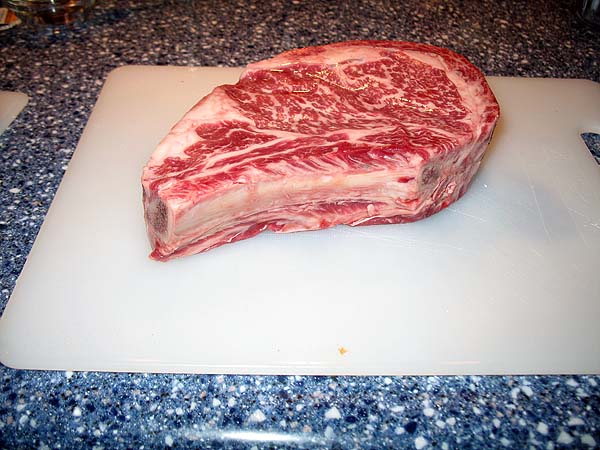
One of the points Ducasse makes is that when you have a piece of meat this good, it's a shame to burn it. He prefers, as do I, to get a good crust on the steak with no charring. Once you char a steak, you're substituting the carbonized flavor of burnt flesh and fat for the, in my opinion, more delicious "roasty" flavor of the Maillard reaction and the beef itself.
Okay, so here's the Ducasse method of making a rib steak, as interpreted by me. This is a 45-minute process, assuming you start with a steak that has been allowed to come up to room temperature or that at least has been out of the refrigerator long enough to take the chill off it. The method starts with a skillet -- in my case cast-iron but any good skillet works fine as does a pot like a rondeau -- heated to a medium heat. The steak is started on its edge. The reason for this is twofold: first, it renders the fat so you're able to cook the steak in beef fat (this echoes Ducasse's principles of flavor reinforcement, which are nearly universal in his cooking); second, it creates an appetizing appearance on the edges.

Note that there was no salt or anything added to the steak before cooking, and that the pan is dry -- no oil etc. You're just putting the steak in the skillet on its edge. If you have a big fat steak (a lot of restaurants would call this a cote de boeuf) then at first it will stand on its edge without help. But eventually you'll have to get creative with the geometry by leaning and propping the steak against the sides of the skillet in order to keep it upright while exposing as many parts of the edge as possible to the heat. If you're willing to stand there with tongs and secure the meat in various positions for 10 minutes you'll get an even more uniform and beautiful crust. Here's how this process unfolds during the first 10 or so minutes of cooking:

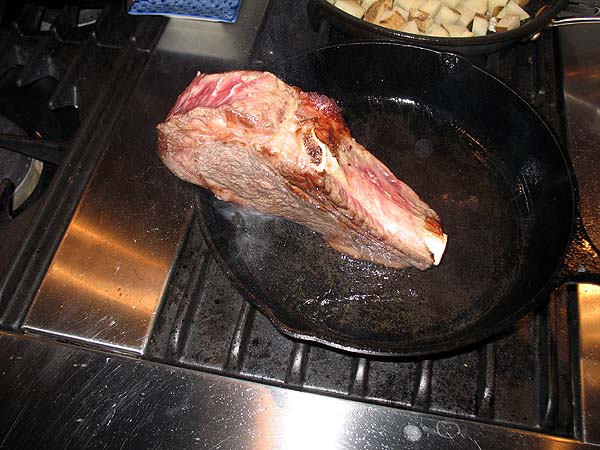
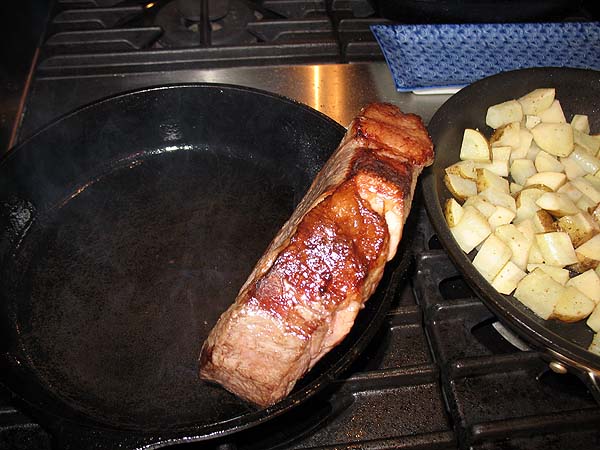
Now it's time to cook the steak on its flat faces, 10 minutes on a side. The way I prefer to do this, which is not exactly the same as how Ducasse recommends in the Times but is something I've seen done in restaurant kitchens, is to dump out enough of the beef fat so that there's a thin coating of it left in the pan, plop the steak on its flat face, and add a couple of tablespoons of butter.

A lot of people recoil at the notion of using butter as a cooking fat with steak, but I've found that butter has two excellent properties: 1- butter, more than most any other fat I know of, is a huge aid to the Maillard reaction, and 2- the combination of butter and beef fat makes a tastier cooking medium for steak than oil.
Now, after about 10 minutes the butter has browned to the point where, if we don't do something, it's going to start imparting burnt flavors to the steak.
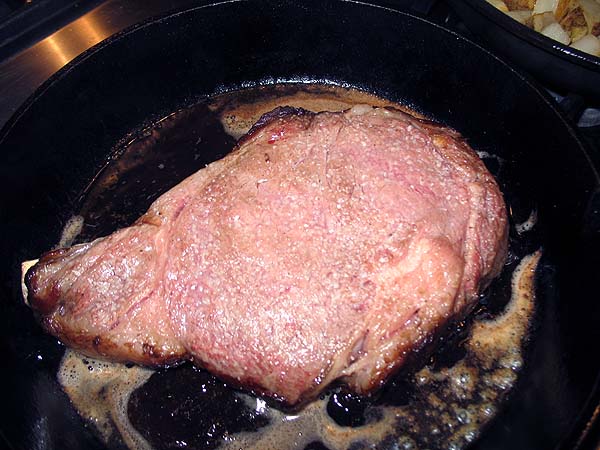
In the first stages of browning, butter has desirable flavors. But eventually, even with medium heat, it breaks down. So it's time to renew the butter by dumping the cooking fat and adding another couple of tablespoons. I believe Ducasse recommends only adding the butter towards the end of cooking, but I think the steak comes out a little better when you use butter all the way through to coax a little more of the Maillard reaction from the steak.
So we are at the 20-minute mark. We've browned our edges and cooked one side of the steak in a mixture of beef fat and butter for 10 minutes over medium heat. We've dumped the fat and flipped the steak. Witness the crust:
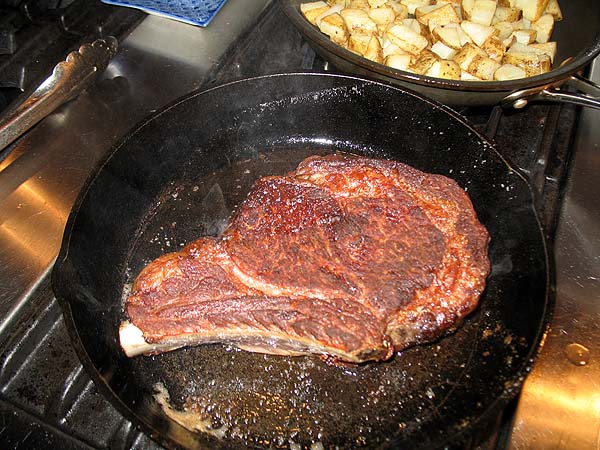
Once I saw that crust -- beautifully browned but not at all charred -- for the first time I became a believer in the Ducasse method. But it gets better. Now you add some more butter, let it melt, and spoon it over the crust (aka basting). This is also when I sprinkle the steak liberally with coarse salt. I know this is much, much later in the cooking process than anybody will tell you to salt a steak, but I find that it yields good results.
Here we are about to baste.
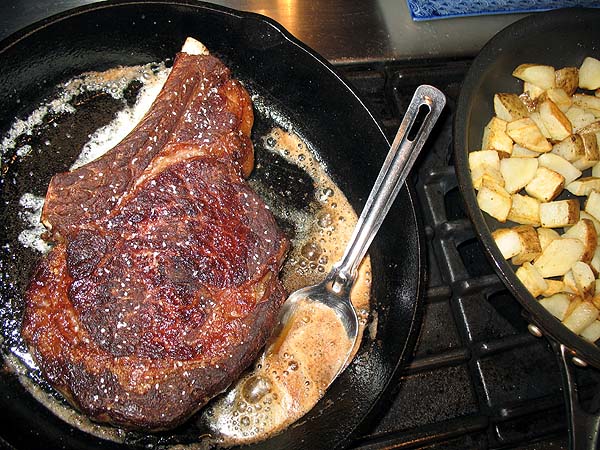
And the crust gets even better after basting.
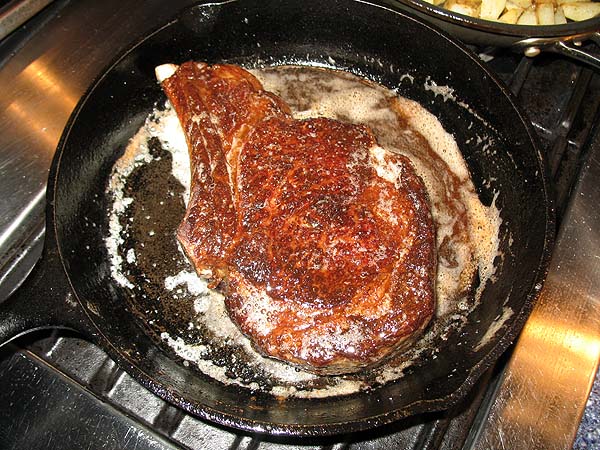
Continue to cook for about another 10 minutes, basting occasionally if you like (though you've derived most of the basting benefit from the first baste).
Now we are almost at the 30-minute mark, so the last thing to do is flip the steak and baste (and salt) the other side.
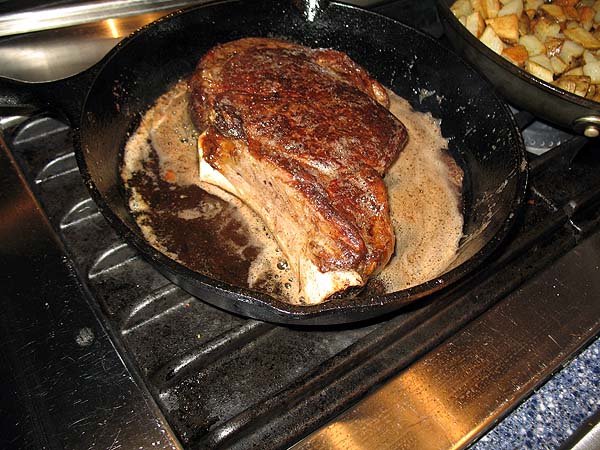
Now the steak will have to rest for 15 minutes in a warm place (the Ducasse rule of thumb is to rest meat for half as long as you cooked it) before being carved. I use a warm plate near the stove. A 150-degree oven is also an option, and if you use on oven you can rest even longer without worrying about the steak getting too cool to be appetizing.

After 15 minutes our home fries are done and our steak is well rested.
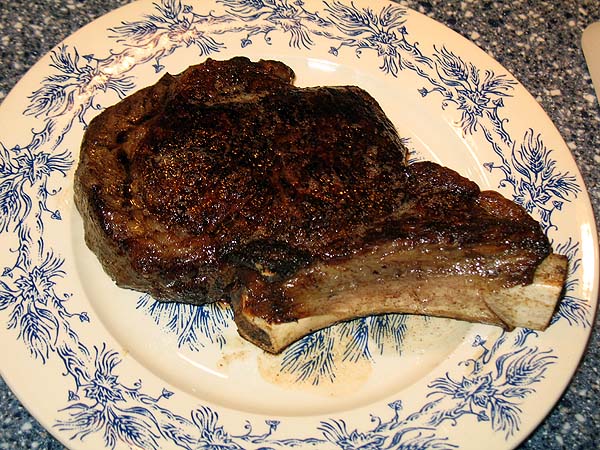
There are fancier ways to carve a rib steak than the way I do it, but this is really simple. You just cut out the bone with a paring knife, then slice the steak. Note that here I use a santoku knife but that's not an expression of personal preference. I don't really like santoku knives. It's just that this happens to be the most recently sharpened knife in my kitchen.

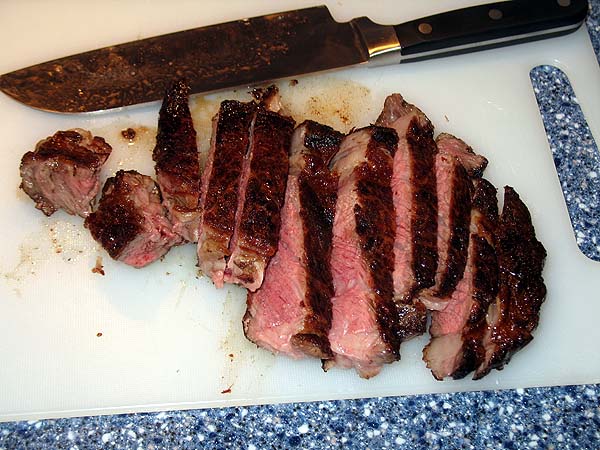
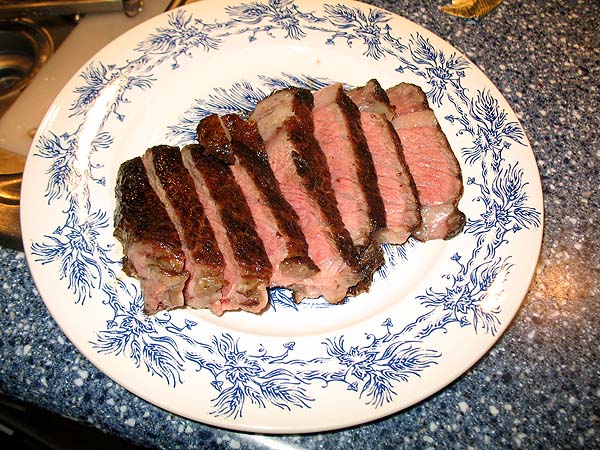
If you look at the Times piece, there are some slight variants between the instructions there and the way I do it. In part that's because I'm not good at following instructions and in part it's because I've seen some variation in actual Ducasse restaurant kitchens where I've spent time watching the line cooks cook steaks. Most of all the method affords a lot of flexibility, so a little more or less flipping, turning and time won't have a huge impact the way it might on a super-hot charcoal grill or under a Jade upright broiler.
A good variant of this method is the one Dave Scantland chronicles in the Daily Gullet in "The Chronicles of Chuck."
I saw this thread revived, read the original post, could not remember ever having seen this thread before (though I'm sure I must have) and thought to myself, "That's EXACTLY how I cook a big steak!", though my one variation is that while the steaks are cooking (one to a pan), I heat up some small, round, "cake-cooling" racks in the oven, so that when it's just a couple of minutes before the steak has to come off and rest, I lift the steak with something hot, slide the hot cake-cooling rack under it, and replace the steak on the rack - so it's lifted above the pan (if there's so much fat that the steak is touching fat, I remove it). At this point the steak finishes cooking from being 1/2 inch above the hot pan, and as the pan cools, the steak rests - it works out great:
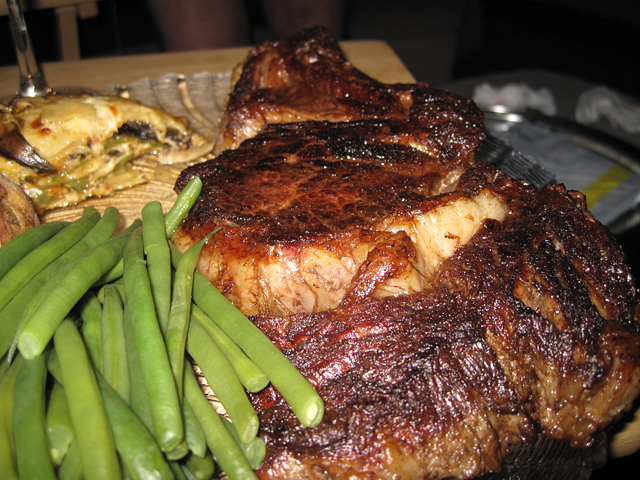
You should only know that I don't know what I did wrong - this steak was waaay overcooked. I don't know where I bungled it. I like 'em dripping red inside, even rarer than the one in the original post, and except for this time, I always get 'em that way. Oh, well.
-
At this point in the thread there are just too many snippets for me to quote, but let me try to comment without quoting a line from each of many messages since I posted last...
I've had some stunningly bad experiences, some with service only, and some with both food and service, at Batali restaurants (the only exception being Lupa).
After one very disastrous dinner entertaining client/friends where both the food and service were horrible at Esca, I wrote to Mario about the experience and never received a reply. When I ran into him a month or two later at Casa Mono (after a mediocre meal that only had one problem which I would've been willing to laugh off till I told him and then he laughed in my face), I told him that I had written to him about a much more serious problem at Esca a month or two earlier, and he turned quite serious (for him), assured me that he did indeed answer every letter he got about such things, and gave me an e-mail address and asked me please to re-send that letter so that he could I answer it. I sent it, and he ignored it again.
Some time after that I took another set of clients (with whom I am also, luckily and happily, quite friendly due to our mutual love of food) to Babbo, and while there were no problems with the service, the food was exceptionally mediocre - to the point that while I, myself, was finding dish after dish to be mediocre, I was also seeing that my guests were leaving significant amounts of the same dish uneaten on their plates (we all had the same thing - I had arranged in advance to do a much-extended "pasta tasting menu" in which we ate most (though not all) of the pastas on the full menu (some with the addition of some definitely not-cheap fresh White Trufffles that had just come into season that year). My guests were trying not to comment on the food that they were being treated for, but course after course there was a lot of moving food around the plate and leaving it (which I was doing too) - which isn't a good sign; in the days when Babbo was new and really trying, plates got devoured and wiped clean. This food was thoroughly disjointed, disconnected, and could not have been more complacently prepared, or less exciting.
So for me that was one hideous experience with really bad food and offensively bad service at Esca, (and one ignored letter from Mario), followed by a mediocre meal at Casa Mono in which Mario laughed in my face about the complaint I made when he asked how everything was that night, (and also and assured me that he answered every letter he got and therefore must not have gotten my more serious letter about the earlier meal at Esca which he asked me to re-send, and then ignored again), followed by a meal with perfectly good service and exceptionally mediocre food at Babbo.
So I'm out! For me there's no point in going to Mario's restaurants based on the track record I've had with the experiences and his response to the problems.
(I exclude Lupa from this - I've never had problems there, but instead have had primarily superb, if too-salty food, but the service has been great (sometimes exceptional, as it was the time I entertained these same clients there by pre-arranging a feast in advance with the GM and chef [this is when Ladner was still there] - and in any case, even if there had been occasional shortcomings at my Lupa experiences which there had not - Lupa's prices are under the point on my radar that I really would get that annoyed.)
So I continue to go to Lupa from time to time when the craving strikes me. As for Mario's other, higher-end restaurants, I get either lousy food, lousy service, or both - and a mocking attitude when I take the time to write and complain about them nicely. I do care that the man lies and tells me that he answers every letter he gets, and then ignores the one letter about something quite serious that I sent him twice, the second time at his request.
With regard to oakapple's post, I haven't had more negative than positive experiences at Babbo - they've run pretty much 50/50. And with regard to chefboy24's comment, "in my experience, letter writing people just want free stuff" - I don't know that he really can make that assumption (based on anything other than psychological "projection") unless he can state that the letters he's received have specifically asked for 'free stuff'. My letter to Mario about the Esca disaster made it very clear that I didn't want anything more than to know that the problem had been acknowledged and hopefully fixed, thinking that I might take those guests back there a second time, as they don't eat meat, which is why I picked Esca in the first place, thinking it might be a treat for them. Instead, we got rude, hostile service, cold food, wrong orders, and in one case the guest who made it quite clear that he was allergic to shrimp and lobster (and was recommended by the waiter to try a particular dish that featured lobster but which they would omit - which was eventually served to him with lobster and a totally miserable and uncaring attitude by the server - prompting these guests to ask me finally "did we do something to offend them, or is the service always like this?" (This was prompted by the fact that this one guest was quite enamored of one of the breads that was served from the roving bread platter and asked for a piece each time the bread waiter came, until the point int he meal when the bread waiter would serve only the table next to us, and then walk away, despite the fact that my guest was asking, loud enough to be heard, for more bread, please. Combine that with wrong orders (the rest of us got the wrong dishes, two of which I had actually seen sit for 20 minutes and get cold, not realizing they were ours waiting for two other dishes to come out) and the fact that everything was mediocre, and you start to see why I called it a disastrous meal.
Ironically, I had told them that a meal at a Batali restaurant would be a treat, not only for the food but the service as well.
So as I say, I'm out. Enough Mario for me for one lifetime!
-
Maybe after Mark left they changed the policy.
I actually told them when I made the reservation - and when I arrived- that I knew you and that you had challenged me to see if I could eat my body weight in duck confit. They were delighted by the idea and said that they had plenty on hand.
But I have to say that it was the quality of the food - every darned course - that was so impressive. Just getting all you can eat of something isn't really a big deal. This was more like the feeling you get at a restaurant with great food that you take progressively smaller and smaller bites because you don't want it to end - and here it doesn't have to. The soup and the pizza were actually show-stopping good, and the oysters were just outrageous - and the idea that we could "just pick four more" was decadent.
Thanks for suggesting this place. I have now found a place that reminds me quite a bit, in taste and in spirit, of a very favorite restaurant in Miami (Michy's) that I miss dearly.
I actually had heard great things about Beacon and always meant to try it - but in gearing up for this meal, I didn't think that each and every course would be as spectacular as it was!
And by the way, I studied the wine list and it looked wonderful - seemed to have lots of delicious bottles at extremely soft prices.
-
Thinking to myself, "Aw, what does Fat Guy know?", I decided to try this here Beacon Sunday Night Skillet extravaganza for myself, because they had one this past Sunday that actually had my name on it (well okay, they called it "Duck Confit"- all I could eat).
Let me say that the entire meal was one of the most delicious, and enjoyable restaurant experiences I have ever had!
We did indeed start with the Pumpkin-Apple Soup which was complex and delicious:
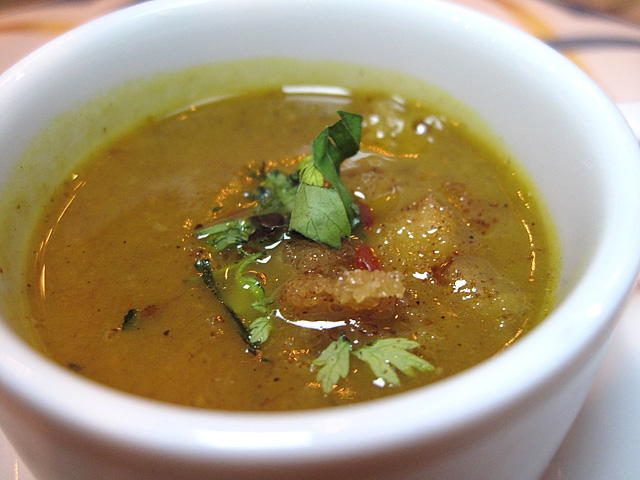
And then did some of their famous (and highly delicious) mushroom pizza:
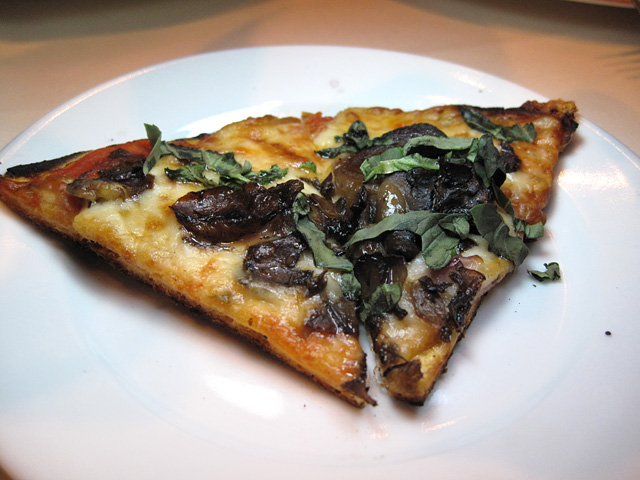
It was at that point that we got bogged down by the stupefyingly delicious wood-roasted oysters:
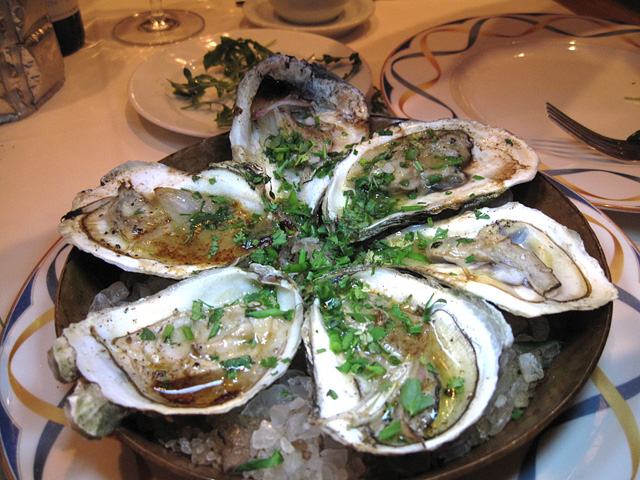
Of course it's silly to be filling up on oysters when you know that all the duck confit you can eat is waiting, but the oysters were so beguiling and captivatingly delicious, that we had to have many (many) orders of them to savor.
We were also brought (and ate several portions of) a quite-perfect arugula salad with crisped potatoes:
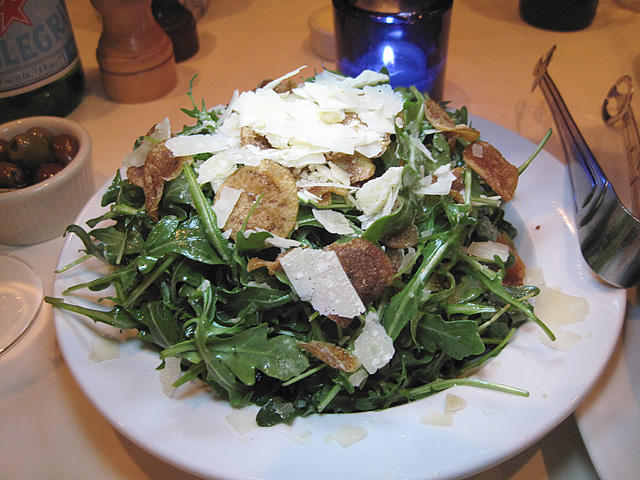
I'm addicted to arugula anyway, but this was such a delicious preparation (and went so well with the duck) that I alone ate several orders of it.
Then the duck confit. Some of the best duck confit I have ever had. As tender and as moist (and as flavorful) as the best confit I have ever had, with a magnificent crisp to the outside.
I think it's hard to tell what you're looking at in the photos because the top of the confit is darkly crisped and the skillet is black, so I'll post a few shots of it:

(That's three pieces of confit fit into one black skillet, with roasted garlic cloves on top; below are two other shots of the same skillet)


The service was possibly the nicest and friendliest service I've ever had outside of Michy's in Miami - and there were several people who made it clear that they were there to take care of our every desire - I point this out because we had come for the all-you-can eat extravaganza at the last possible moment of arrival, and delayed the meal so much with all the roasted oysters we kept ordering, that I was genuinely impressed (and touched) when someone came over after I had demolished two of the portions of confit (my partner was done in after his one) to ask if we'd like more. It was sooooo delicious that I debated it, but I realized that the saner thing to was to call it quits after two rather large (and extremely rich) portions.
Although the ice cream Sundae was explained to us, all we could do was pick at a little very delicious vanilla ice cream as we sat for a while, content.
The BYO aspect was fantastic. I had a lot of fun going through my cellar trying to decide what to drink with wood-roasted oysters, and wound up bringing quite a number of bottles of possibly-too-old whites (Riesling, Pinot Gris, Gewurztraminer) that I had hand-carried back from a long trip to Alsace a while ago, and the waiter was great at keeping the labels hidden from my partner who I made guess them (and decide which went best with the oysters). Our fantastic waiter, who very cleverly realized what we were doing and simply brought a tremendous number of empty wineglasses to our table and set them up for us, preferred the Gustav Lorentz Grand Cru "Altenberg de Bergheim" 1995 (not shown).
But for the confit I went right to the big guns and brought a very magnificent half-bottle of the 1986 Sociando-Mallet, (which is drinking beautifully now, and as Robert Parker says, will very clearly go until at least 2040):

But the star of the evening was Beacon restaurant, its people, and its food. Waldy Malouf wasn't there, but Sous Chef Joel Orsini presided over a truly magnificent meal - I can't remember the last time I enjoyed a meal that much.



tarte d'alsace
in France: Cooking & Baking
Posted
The original uses half fromage blanc and half Crème fraîche which have been blended together. This I know for a fact.